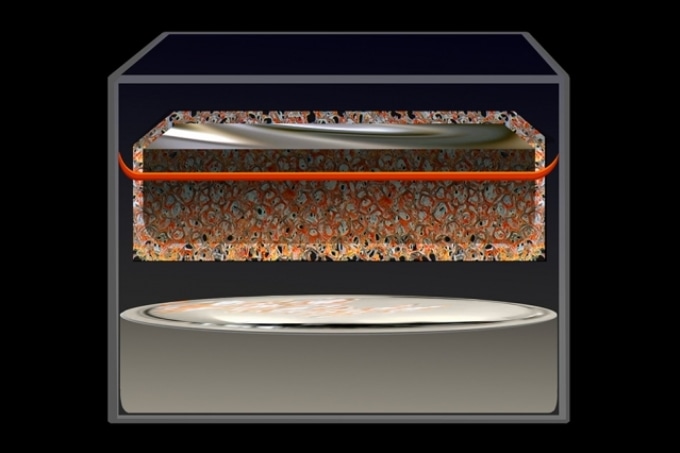Jan 23 2018
MIT researchers have developed a new approach to large-scale rechargeable batteries which could solve the longstanding issues and lead to low-cost power storage. Thanks to this latest finding, a type of battery, which was first developed almost 50 years ago, could be projected to the forefront of energy storage technologies. Based on electrodes made of sodium/nickel chloride, the battery uses a novel type of metal-mesh membrane. Such a battery could possibly be used for grid-scale installations, to make intermittent power sources such as solar and wind that can deliver reliable baseload electricity.
A research team, headed by MIT professor Donald Sadoway, postdocs Brice Chung and Huayi Yin, and four others, reported these findings in the journal Nature Energy on 22nd January, 2018.
Although the researchers used the basic battery chemistry, based on a liquid sodium electrode material and initially described in 1968, the concept never became popular as a practical method due to one major drawback: a thin membrane had to be used to isolate its molten components and the only known material that had the required properties for that membrane was a fragile and brittle ceramic. These membranes were thin as a paper and made the batteries to become more easily damaged in real-world operating conditions. Hence, barring a few specialized industrial applications, the system has never been implemented on a wider scale.
However, Sadoway and his team employed a different method, after knowing that the functions of that specific membrane could rather be carried out by a specially coated metal mesh – a more flexible and relatively stronger material that could withstand the rigors of use in industrial-scale storage systems.
“I consider this a breakthrough,” Sadoway says, because for the first time in 50 years, this kind of battery — whose benefits include an ability to go through many charge-discharge cycles without degradation, extremely safe operational characteristics and cheap, abundant raw materials — could at last become practical.
 A type of battery first invented nearly five decades ago could catapult to the forefront of energy storage technologies, thanks to a new finding by researchers at MIT and other institutions. (Image credit: Illustration modified from an original image by Felice Frankel)
A type of battery first invented nearly five decades ago could catapult to the forefront of energy storage technologies, thanks to a new finding by researchers at MIT and other institutions. (Image credit: Illustration modified from an original image by Felice Frankel)
Although some companies have continued to develop liquid-sodium batteries for unique applications, “the cost was kept high because of the fragility of the ceramic membranes,” says Sadoway, the John F. Elliott Professor of Materials Chemistry. “Nobody’s really been able to make that process work,” including GE, which spent almost a decade working on the technology and finally abandoned the project.
When Sadoway and his team investigated the numerous options for the varied components in a molten-metal-based battery, they were amazed by the outcomes of one of their tests using lead compounds.
“We opened the cell and found droplets” within the test chamber, which “would have to have been droplets of molten lead,” he says. However, instead of behaving as a membrane, as predicted, the compound material “was acting as an electrode,” actively participating in the electrochemical reaction of the battery.
“That really opened our eyes to a completely different technology,” he says. The membrane had executed its role, i.e., selectively enabling some molecules to pass through whilst blocking others in an entirely unique way, utilizing its electrical properties instead of the usual mechanical sorting based on the material’s pore size.
The researchers experimented with various compounds and ultimately discovered that a normal steel mesh coated with titanium nitride solution could carry out all the functions of the ceramic membranes used before, but without the fragility and brittleness. These results could make a complete range of durable and low-cost materials viable for large-scale rechargeable batteries.
According to Sadoway, the latest type of membrane can be applied to an extensive range of molten-electrode battery chemistries and it also presents new opportunism for battery design. “The fact that you can build a sodium-sulfur type of battery, or a sodium/nickel-chloride type of battery, without resorting to the use of fragile, brittle ceramic — that changes everything,” he says.
Sadoway also added that this latest study could lead to low-cost batteries that are sufficiently large enough to make intermittent, renewable power sources feasible for grid-scale storage and the same, unique underlying technology could also have other applications, such as for certain kinds of metal production.
However, Sadoway cautions that such types of batteries would not be appropriate for some key applications, such as phones or cars. The point of these batteries lies in large, fixed installations where cost is important, but weight and size are not; for example, utility-scale load leveling. In such applications, low-cost battery technology could possibly allow for a much greater percentage of intermittent renewable energy sources to replace baseload power sources that are always available and are currently dominated by fossil fuels.
The research group also included MIT research scientist Takanari Ouchi, Fei Chen at Wuhan University in China, and postdocs Nobuyuki Tanaka and Ji Zhao. The French oil company Total S.A. supported the work.